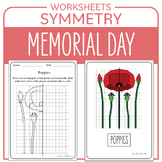20 results
Higher education precalculus laboratories

Make Multiple Vectors Fun! Pirate Treasure Hunt - Physics, Trigonometry
This is one of my student’s favorite activities. Who doesn’t want to go outside and map out some vectors? It works well in physics or trigonometry for understanding how to add and subtract multiple vectors. 10 different maps are provided for student groups to make their way from a single point of origin to a designated, X-marks-the-spot, using compass headings of N, S, E, and W and specified distances. The groups all have a different path but end up at the same place. At the end, students dr
Subjects:
Grades:
8th - 12th, Higher Education, Adult Education
Types:
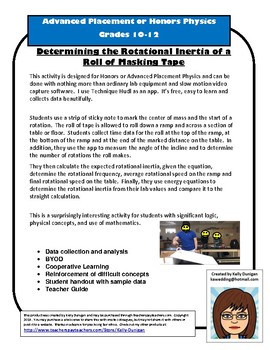
Rotational Inertia of a Roll Of Masking Tape Lab - Honors or AP Physics
Determining the Rotational Inertia of a Roll of Masking TapeThis activity is designed for Honors or Advanced Placement Physics and can be done with nothing more than ordinary lab equipment - meter sticks, a balance, and an inclined plane (I use foam core science fair boards) and slow motion video capture software. I use Technique Hudl as an app. It’s free, easy to learn and collects data beautifully but you can use any slo-motion app you'd like or even use a stop watch though your data won't be
Subjects:
Grades:
10th - 12th, Higher Education
Types:
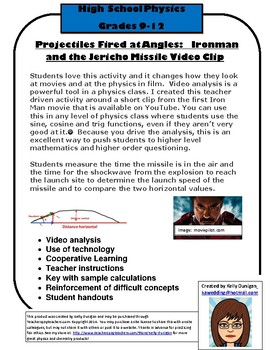
Projectile Motion Video Analysis Jericho Missile Iron Man
Students love this activity and it changes how they look at movies and at the physics in film. Video analysis is a powerful tool in a physics class and your students will look forward to the next one.
I created this teacher driven activity around a short clip from the first Iron Man movie that is available on YouTube. You can use this in any level of physics class where students use the sine, cosine and trig functions, even if they aren’t very good at it. Because you drive the analysis, thi
Subjects:
Grades:
9th - 12th, Higher Education
Types:
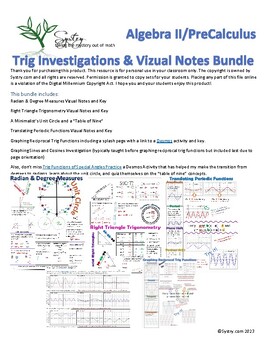
Trig Bundle
This bundle includes: Radian & Degree Measures Vizual Notes and KeyRight Triangle Trigonometry Vizual Notes and KeyA Minimalist’s Unit Circle and a “Table of Nine” Translating Periodic Functions Vizual Notes and KeyGraphing Reciprocal Trig Functions including a splash page with a link to a Desmos activity and key.Graphing Sines and Cosines Investigation (typically taught before graphing reciprocal trig functions but included last due to page orientation)Also, don’t miss Trig Functions of Sp
Subjects:
Grades:
10th - 12th, Higher Education
CCSS:
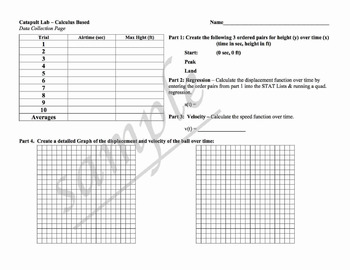
Polynomial Labs (Quadratics, Cubics, etc.) including Catapults!
This lab includes two versions of a catapult lab (calculus based and non-calculus based). Students work in groups to collect data on a ball launched using a catapult. Students create regression equations using a graphing calculator or spreadsheet.
Also included is a painted cubes lab that includes 4 types of functions.
Courses: algebra 1, algebra 2, pre-calculus, calculus
Here are links to my other algebra projects:
Click Here to see my project: Indirect Measurement Labs
Click Here to see
Subjects:
Grades:
8th - 12th, Higher Education, Adult Education
Types:
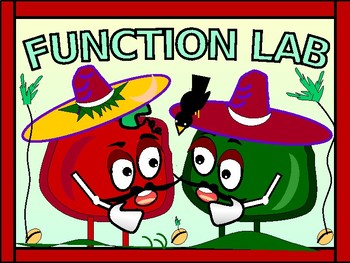
Math Lab:Exponential Functions and Seed Overproduction vs Time/DISTANCE LEARNING
My students totally enjoy doing the following math lab! They invariably find it to be both fun to do as well as informative. They readily relate to discussions within.
* Students work with a partner
* Students begin by a brief discussion about seed overproduction
* Students are provided with assumptions used to complete the lab
* Students work collaboratively to determine the number of seeds in a bell pepper
* Students find the average number of seeds in a bell pepper using the totals
Subjects:
Grades:
7th - 11th, Higher Education, Adult Education
Types:

Exponential Logarithm Trigonometric Activities and Labs
This project set includes 8 projects that are cooperative learning, hands-on labs. Students collect data that fit exponential, logarithmic, or trigonometric patterns. Students will create equations from the data and use the equations to make predictions. Many of the equations students create will be through the regression process on graphing calculators or spreadsheets.
classes: algebra 2, pre-calculus, calculus, applied math
Here are links to my other algebra projects:
Click Here to see m
Subjects:
Grades:
9th - 12th, Higher Education, Adult Education
Types:
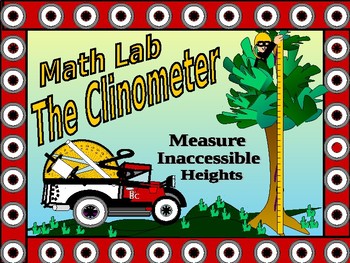
Math Lab: The Tangent Ratio, a Clinometer, and Inaccessible Heights
The following math lab is a follow-up to lessons on the Trigonometric Ratios:* In the lab, students follow steps to create a measuring device called The Clinometer* Students use the Clinometer to measure objects of inaccessible heights such as trees or flag poles.* To measure the objects, students use their Clinometer and apply the Tangent Ratio.* Students work with a partner. * One partner looks through the Clinometer while the other partner records the data required to calculate the tange
Subjects:
Grades:
7th - 11th, Higher Education, Adult Education
Types:

Calculus - Continuity
This activity engages the students in understanding the three parts of the definition for a continuous function at a point by asking a series of questions about several functions.You also might be interested in the Activity Sheet on Continuity and the Intermediate Value Theorem that is available in my store. A recent buyer said "Thank you for providing this resource. I appreciate your time and investment in creating a helpful resource."
Subjects:
Grades:
11th - 12th, Higher Education
Types:
Also included in: Calculus - Continuity Bundle
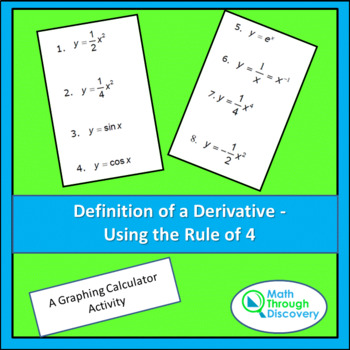
Calculus - Definition of a Derivative - Using the Rule of 4
This activity incorporates the graphing calculator to help students understand the definition of a derivative. Students in AP Calculus and Calculus should be studying the concepts in Calculus graphically, numerically, verbally and analytically ( which is also known as the rule of 4). This activity sheet will help develop the student’s conceptual understanding of the definition of a derivative in these four ways:• Students create graphs and tables of a function and a difference quotient. As th
Subjects:
Grades:
10th - 12th, Higher Education
Types:
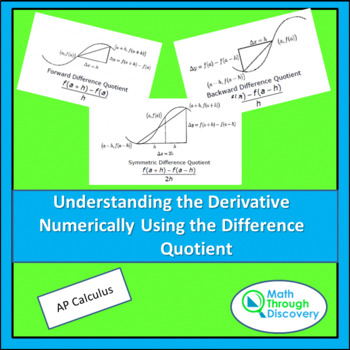
Calculus - Understanding The Derivative Numerically
This activity incorporates the TI84 and TI84C Graphing Calculator to study how the three difference quotients approach the same limit. Students write equations to match sets of table values as the limit of h approaches zero.
Subjects:
Grades:
10th - 12th, Higher Education
Types:
Also included in: Calculus - Understanding the Derivative Bundle
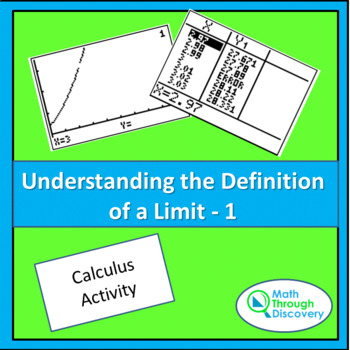
Calculus - UNDERSTANDING THE DEFINITION OF A LIMIT-1
Students often struggle to understand the formal definition of a limit. This activity sheet has the students build both tables and graphs to see what the definition is saying. In the tabular form, the students keep refining the table to be convinced that as long as they stay very close to a value of a on the x-axis all y values will stay in a close range of a particular number called a limit. The same idea is explored graphically by trying to keep all y values visible when given a particular
Subjects:
Grades:
11th - 12th, Higher Education
Types:
Also included in: Calculus - 3 BUNDLED LESSONS ON UNDERSTANDING THE DEFINITION OF A LIMIT
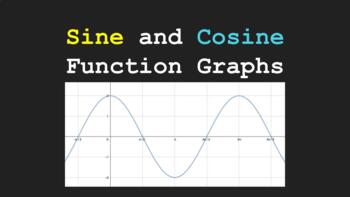
Discovering Sine and Cosine Function Graphs
In this activity, students will use a linked Geogebra to explore the graphs of sine and cosine functions. They will manipulate the amplitude, the period, the phase shift, and the vertical shift parameters to determine how changing those parameters in the function affects its graph. They will reflect on how the algebra of the function relates to its geometry. They will then reflect upon what they have done by coming up with an equation for the period of the functions, exploring the sine/cosine
Subjects:
Grades:
9th - 12th, Higher Education
CCSS:
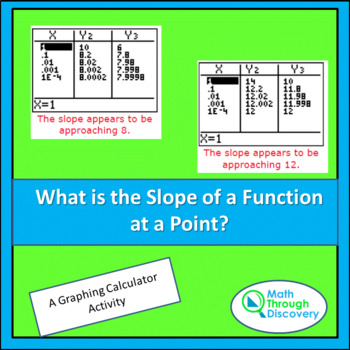
Calculus - What is the Slope of a Function at a Point?
This graphing calculator activity engages the students in using two difference quotients and table values to approximate the slope of a function at a point. Students first study y = 2x^2 at the point (1,2). Using the two difference quotients, students find that the slope is 4. The students then explore find the slope of the same function at x = 2, 3, -1, -2, and -3. They then conjecture what the slope will be at A = -4, +4, and 0. Student then move to studying the slope along y = x^3 y =
Subjects:
Grades:
11th - 12th, Higher Education
Types:
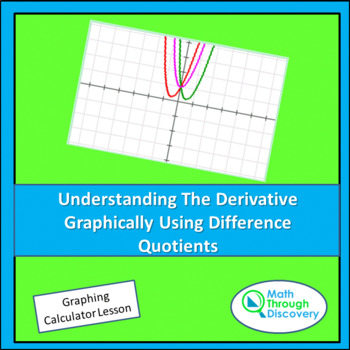
Calculus - Understanding The Derivative Graphically Using Difference Quotients
Students can used their graphing calculators to build an understanding for the formal definition of a derivative (limit as h approaches zero of (f(x+h)-f(x))/h). Students will set up the forward difference quotient, the backward difference quotient, and the symmetric difference quotient approaching the same limit. Then students will let h equal 1, 0.1, 0.01, and 0.001) to notice that all the difference quotients approach one function. The function they are all approaching will be called t
Subjects:
Grades:
10th - 12th, Higher Education
Types:
Also included in: Calculus - Understanding the Derivative Bundle

Math Lab: Investigating Volume/DISTANCE LEARNING/NO PREP
In the following lab, students enjoy a "hands-on" activity to learn the reasoning behind the formulas used in calculating for volume in two solids, the pyramid and the prism.
* Students draw the nets on poster board for a pyramid and a prism, given precise measurements.
* Students carefully cut the nets out and fold according to directions.
* Students use unpopped popcorn, uncooked rice, or dried beans to fill their solids.
* Students compare the volume of a pyramid and a prism with
Subjects:
Grades:
7th - 12th, Higher Education, Adult Education
Types:

Pre-Calc: Inverse Relationship Between Logs & Exp (Graph Calc)
This activity uses the graphing calculator to explore the inverse relationship between logs and exponential functions. Students use the table feature of their calculator to generate values for inverse functions and to explore/compare components of each. This is generally an in-class group activity but could be assigned outside of class. Used in PreCalc as a discovery lesson and in Calculus as a review.
Subjects:
Grades:
11th - 12th, Higher Education
Types:
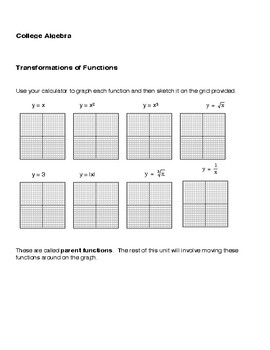
Algebra: Transformations of Functions Lab
This activity can be done alone, at home, or in groups. Using graphing calculators, students first graph parent functions (linear, quadratic, cubic, square root, etc). Then they perform a series of transformations and write down what they notice. This will lead them to the correct conclusion as to the meaning of A, B, C & D in the equation. No key is provided.
Subjects:
Grades:
8th - 12th, Higher Education
Types:

Geogebra Photo Functions
This lesson integrates technology to allow students to explore families of functions. Students must know translations of quadratic functions in order to complete this activity. Further knowledge of functions is valuable but not necessary.
This lesson also requires the use of Geogebra--a free interactive geometry software. A web version is available, but the instructions are specific for the Windows downloaded version. This lesson could easily be adapted to any Geogebra version.
CCSS F-BF
3.
Subjects:
Grades:
8th - 12th, Higher Education, Adult Education
Types:
CCSS:

Limits at Infinity of Rational Functions Discovery Worksheet
This discovery worksheet provides a nice little introduction to limits at infinity of rational functions. The students get to be a mathematician; they will find patters and develop a conjecture. This way, the students discover the trick to finding these particular limits, instead of simply given a rule. Works well with small groups.
Subjects:
Grades:
11th - 12th, Higher Education
Types:
Showing 1-20 of 20 results

